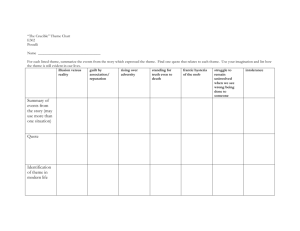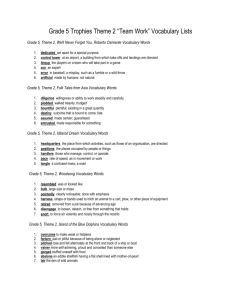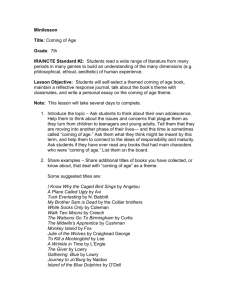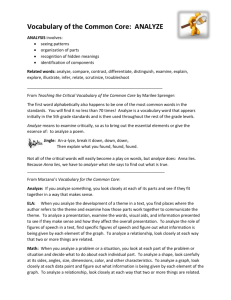“Sources of miscommunication at work”
advertisement
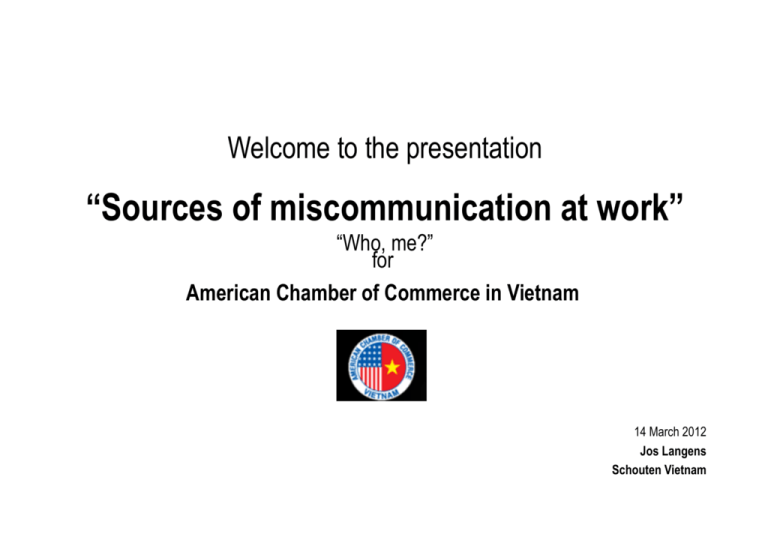
Welcome to the presentation “Sources of miscommunication at work” “Who, me?” for American Chamber of Commerce in Vietnam 14 March 2012 Jos Langens Schouten Vietnam Jos Langens • CEO and Trainer of Schouten Vietnam • Masters in Psychology, University of Utrecht, the Netherlands • Worked at ING Bank (Corporate banking and Life Insurance) and Fortis Bank (SME enterprises) • Owner / founder of VNR Business Support Key Facts & Figures Head office in Zaltbommel • 1980 start by Jan Schouten • Turnover > USD 100 million • > 6.000 customers • 12 operating companies • Presence in 14 countries worldwide • > 600 employees • Network of 1.800 freelance specialists Broadening our horizon Services 450 patent protected programs • • • • • • • • • Soft skills trainings (In-company and public programs) - Leadership - Effective Communication - Management - Assertiveness - Etc.............. Training for Trainers - Teambuilding - Presentation Certified coaching programs MBA program (Schouten University) Publisher (over 20 titles available in English) Consulting, Organisational development Assessments (MBTI) Competency scans (for career assessment and career development) E-learning, E-training. E-coaching (software tools) 4 basic rules of communication Basic rules of communication 1. You cannot not communicate 2. All behaviour is communication 3. You never get your message across 100% 4. Communication is: < 30% verbal and > 70 % non-verbal Sender – Message - Receiver Communication is the process of transferring information from one entity (sender) to another (receiver) Effective communication is a process where a message is received and understood by the receiver in the manner that the sender intended it to be. Sender – Message - Receiver Miscommunication occurs when the message is understood in a different way as the sender it intended to be. What are these sources of miscommunication? Noises in communications External distractions: - Traffic noises - Colleagues entering the room - You’re observing the environment - Your neighbour making a phone call - A mosquito in the room - Defect airco - Uncomfortable chair - ... Internal distractions - Lack of concentration (e.g. fantasize, …) - Listening with prejudice - Don’t feel well - Being tired/sleepy (after lunch..) - Being worried - ... How about our perception? Our perception VERBAL (<30%) NON-VERBAL (>70%) • Selectiveness : I hear, … I hear, see, smell,… • Interpretation : I think ….. I think …… • Judgement : I find ….. I find …….. • Behavior : I do ….. I do …… Our perception Personal filter : your colored glasses • Previous experiences • Norms & values • Preconceived ideas • Assumptions • Halo effect • ….. Sources of miscommunication: • External noises • Internal Noises • Selective observation • Different interpretation (thoughts) • Different judging • Limited perception Each message that we send out in fact contains 4 different messages (4 different aspects). So whenever you “say” something, the question is: ...., “What is it exactly that you are saying?” 4 aspects of communication 1. Your employee tells you: “I called more than 5 suppliers already, but they all didn’t have the material that you want” 4 aspects of communication 2. Your boss asks you: “are you still busy with that task?” 3. When you visit your grandmother after a long time, she says: ”Nice that you’re here again”. 4 aspects of communication (the 4 ears model) 4 aspects of communication • Content (“it”): What is at stake, the subject, the WHAT of the message, the text • Appeal (“you”): What is the underlying question? What is the actual purpose of this message what does the sender wants to accomplish with the receiver? • Self disclosure (“I”) : What does the sender convey or express about him-/herself with these words? • Relationship (“we”): What I think does the sender think about the other person and his/her relation with the receiver? 4 aspects of communication (what do you intend to say – what does the receiver hear) “There’s a fly in my soup!” Content: “There’s a fly in my soup” Self –disclosure: The Message: Appeal: “I am angry!” “There’s a fly in my soup” “Get me a new soup ” Relation: “I’m your customer” 4 aspects of communication (different ears - different answers) “There’s a fly in my soup!” Self –disclosure: “I’m very sorry about this” Content: “Yes, I can see that” The Message: “There’s a fly in my soup” Relation: “I will take care about this” Appeal: “I will get you a new soup” Miscommunication happens when .... The challenge is to find out ....... what is the MAIN ASPECT of the message …. ….. and reply on this MAIN ASPECT! One more example …… 4 aspects of communication (discovering the real message) What could be the main message? Content: “It’s raining outside” Self –disclosure: The Message: “I am worried that you will catch a cold” “It’s raining heavily outside” Relation: “You yourself can’t take the right decision” Appeal: “You should put on your rain coat ” 4 aspects of communication (different ears – different answers) Content: “I can see that” Self –disclosure: “Don’t worry, I’m used to it” The Message: “It’s raining heavily outside” Relation: “I can take care of myself” Appeal: “I’ll put on my rain coat” 4 aspects of communication 1. Your employee tells you: “I called more than 5 suppliers already, but they all didn’t have the material that you want Content “Just an update FYI” “OK, thanks!” Self-disclosure “I’m worried that you will be disappointed in me” Appeal The Message: “Don’t worry, I know it’s not an easy job to do” “I called more than 5 suppliers already, but they all didn’t have the material that you want” “I want to be a good employee” “I appreciate that you inform me (you’re a good staff) Relation “Can you help me what to do?” “Just keep on trying” When things go wrong …….. 4 aspects of communication 2. Your boss asks you: “are you still busy with that task?” Content “Just to check” “Yes, I still am” Self-disclosure “I doubt about your capability to solve this” Appeal The Message: “Nobody could have finish this task by now” “Are you still busy with that task?” “As a boss I should check your progress” “Yes we are now in the final stage” Relation “Can’t you speed it up a bit ?” “It will be finished in two days more” When things go wrong …….. 4 aspects of communication 3. When you visit your grand mother after a long time she says: ”Nice that you’re here again”. Content “It’s nice that you are here again” “Yes, isn’t it?” Self-disclosure “I missed you very much” Appeal The Message: “I missed you a lot” “Nice that you’re here again” “You should take better care of your grandmother” “I wished I could do more” Relation “I wished I could “You should visit visit you more often if I just me more often” weren’t so busy” When things go wrong …….. How to minimize this source of miscommunication? • Try to be aware of the 4 different aspect in each message. • Ask yourself the question: “what is the main aspect of this message”? Try to figure out ......., ........ “what” exactly it is you want to say?” Learn to listening with 4 ears! 4 aspects of communication Your staff tells you: “if you want me to finish that work today, I probably have to work until 11 this evening.” What do you hear? Content: “If … until 11 this evening” Self –disclosure: The Message: Appeal: “I feel really bad about this” “If you …. have to work until 11 this evening” “You have to compensate me for this” Relation: “As a boss you can’t ask me to do this” 4 aspects of communication When you go to work, your wife asks you: “will you work late again tonight?” What do you hear? Content: “Will you work late again tonight?” Self –disclosure: The Message: Appeal: “I feel so lonely at night” “Will you work late again tonight?” “Can’t you come home early tonight?” Relation: “You should take better care of me” 4 aspects of communication Your staff informs you that “the husband of a colleague is an alcoholic”. What do you hear? Content: “Chi’s husband is addicted to drinking” Self –disclosure: The Message: “I am worried about her” ”Chi’s husband is an alcoholic” Relation: “I want to be your friend” Appeal: “You should help her” 4 aspects of communication Miscommunication occurs when you react to the wrong aspect of the message..... .... when you listen with your wrong colour ears.......... Dis-functional Interaction Patterns (behavioral pitfalls) Pattern 1 “They won’t cooperate” Theme: Ownership of a problem Players: - The boss - The staff Pattern 1: “They won’t cooperate” Ownership of a problem Boss: Staff: “Can you solve this problem?” “Yes I can!” .... .... “Did you manage to solve the problem?” “No, not yet” “Why not?” “Nobody answered the phone” “What now?” “I don’t know” “Why don’t you call some other companies?” “Oh, OK I will” ...... ....... Pattern 1: “They won’t cooperate” Ownership of a problem Boss: Staff: “Did you manage to solve the problem?” “No not yet” “Why not?” “Everyone that I called didn’t have “What now?” “I don’t know” “Can you order it from abroad?” “Yes I think I can” ...... ....... “Did you manage to solve the problem?” Pattern 1: “They won’t cooperate” Ownership of a problem Boss: Staff: “No not yet” “Why not?” “The import tax is too high, we won’t “What now?” “I don’t know” “How about if we would import only some parts and assemble in Vietnam?” “Oh, that might be possible, I will check” ...... ....... “Did you manage to solve the problem?” ........ ???? Pattern 1: “They won’t cooperate” Theme: Ownership of a problem Boss (“Can you solve that problem?”) Staff (“Yes I can”) Functional pattern Pattern 1: “They won’t cooperate” Theme: Ownership of a problem Staff (“I don’t know what to do”) (“Can you help me?”) Boss (“Yes I can”) (“Let me tell you what to do”) Dis-functional pattern Pattern 1: “They won’t cooperate” Theme: Ownership of a problem The solution: When your employer doesn’t know what to do.... ........ don’t tell them what to do ........... ....... make sure the goals are clear ........ ... help your staff to discover the various options to reach the goals .... Don’t tell them what to do and how to do it. Pattern 1: “They won’t cooperate” Theme: Ownership of a problem Boss: Staff: “Can you solve this problem?” “Yes I can!” .... .... “Did you manage to solve the problem?” “No, not yet” “Why not?” “Nobody answered the phone” “What now?” “I don’t know” “Why don’t you call some other companies?” Correct reply: “ What are the other options” “How can you still reach your goals? ....... Dis-functional Interaction Patterns (behavioral pitfalls) Pattern 2 “I’m just trying to help you” Theme: Problem Solving Players: - The “Victim” - The “Helper” Pattern 1: “I’m just trying to help you” Theme : Problem solving “Victim”: “Helper”: “My staff never shows any initiative” “Did you talk with them about it?” “Yes,I did but it made no difference” “You should give them more “I tried that already, but it didn’t work” “Maybe you can send them to a training” “I’m not sure if that would help” “ Well it did in our company” “Yes, but you’re in Construction, we are in FMCG” “Looks like you don’t really want to listen ”You don’t seem to understand the problem” Pattern 1: “I’m just trying to help you” Theme : Problem solving “Victim” “Helper” “Persecutor” Pattern 1: “I’m just trying to help you” Theme : Problem solving The solution: When somebody has a problem.... ........ don’t give YOUR solutions........... ....... try to help them discover what their OWN solutions are. Pattern 1: “I’m just trying to help you” Theme : Problem solving “Victim”: “Helper”: “My staff never shows any initiative” “Did you talk with them about it?” Correct reply: “Why is that a problem?” “Well that seems obvious, doesn’t it?” “Well not really, maybe you could explain “When we would make use of their ideas we can have much better solutions for our problems” staffs’ ........... “You want to make use of your potential to solve problems in a better way”? “What could be ways to do this?” Dis-functional Interaction Patterns (behavioral pitfalls) Sometimes you don’t just “slide” into a dis-functional pattern …… Sometimes you’re actually reinforcing it without realizing it! You’re the actual “cause” that keeps the disfunctional pattern alive. Dis-functional Interaction Patterns (behavioral pitfalls) Pattern 3 “They must become more entrepreneurial” Theme : Reinforcing the wrong behavior Players: - The Manager (and their Consultants) - The Staff Pattern 3 “They must become more entrepreneurial” Theme : Reinforcing the wrong behavior “We have to change them so that they will show more initiatives.” “They must realize it’s better for them.” “The must understand the importance of this”. “They must follow the program that we designed for this.“ They must….” “They should …” “They have to …” Pattern 3 “They must become more entrepreneurial” Theme : Reinforcing the wrong behavior What was the result of all these programs? Pattern 3 “They must become more entrepreneurial” Theme : Reinforcing the wrong behavior Did you actually train your staff to take more initiative? Which behavior did you reinforce? Pattern 3 “They must become more entrepreneurial” Theme : Reinforcing the wrong behavior “Conclusion”: In stead of “changing” the behavior, you are actually reinforcing the behavior that you want to change. Who would be the source of THIS miscommunication? Dis-functional patterns a source of miscommunication How to deal with disfunctional patterns: 1. Recognize the patterns: • Repeating patterns (“deja vu”) • Your emotions (your underbelly feeling) • Helicopter view 2. Recognize your own role in the disfunctional pattern (“who, me?”): • Establishing the pattern • Reinforcing the pattern 3. Changing the disfunctional pattern: • By changing your own behavior (jiu jitsu) • By openly discussing the pattern with the involved (process interventions) people Sources of miscommunications (summary) Individual differences in perception • Selectiveness • Interpretation • Judgement Listening with 4 ears • Finding out what the real message is (main aspect) Disfunctional patterns • How we start them • How we reinforce them • How to prevent them or correct them Sources of miscommunications Conclusion: What are the 3 main sources of miscommunications? • Me • I • Myself Good luck in your career and private life! Jos Langens Jos.langens@schoutenvietnam.com 0903 727 059 Mobile 08 – 3914 1234 Tel. www.schoutenvietnam.com





